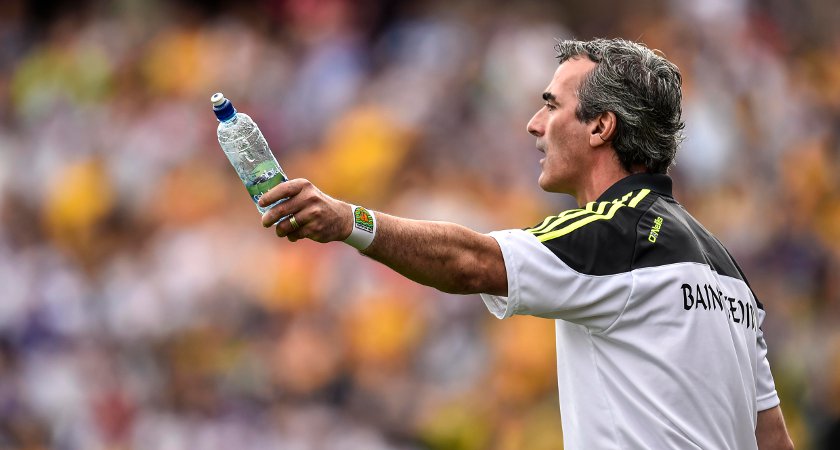AT THE end of last season, the opportunity to travel to Australia for ten days was presented to the Dublin football squad. It was briefly explored before being knocked back for logistical reasons.
In the end, around 70 per cent of the squad went to London for two nights in early December, taking in a Chelsea match at Stamford Bridge. Winning another league and Leinster Championship entitled them to a longer break, but some of the players felt that two days mirrored what they deserved.
Jim Gavin and a lot of Dublin players put down a hard winter. Dublin appeared indestructible last summer but when Donegal punctured such a deep hole in their aura, other teams could finally see through it.
Repairing that damage and restoring confidence was the only starting point for Gavin and his players.
The Donegal defeat hit Dublin hard. Some players privately admitted to being in shock afterwards. It took a few of them three or four months to get over it. The toxins clearly lingered in their system during the early spring. Heading into Round 5 of the League, Dublin were second from bottom of Division 1A.
Part of that was down to Dublin experimenting with different styles. They were playing more defensive. In four of their first six matches, Dublin had only registered scores of 1-9, 1-10, 2-10 and 0-8.
After struggling against Tyrone’s massed defence, they had the same difficulties against Derry, in what looked like a game from the apocalypse.
“That really worried me,” said former player Ciarán Whelan at the time. “When Dublin didn’t play off the cuff, and they had to be patient and retain possession, it got into their psyche. It totally slowed them down. They weren’t breaking the gain-line. The support-runners weren’t coming.”
Their devastating performance against Monaghan in Round 7, when they nailed 1-22, suggested Dublin were finally coming to terms with massed defences. After blitzing Cork with 1-21 in the league final, Dublin looked to have cracked the code. The aura was shining brightly again.
Heading into the championship, Dublin found themselves in exactly the same position they were 12 months earlier. They were 6/4 favourites to win the All-Ireland. Yet this time around, they entered the summer with the best defensive record of all 32 teams in the league. With a point to prove, big names to return and their defensive kinks smoothed out, were they more bombproof this time around?
Last June, Jim McGuinness spoke about systems in team sports, ranging from Dublin to Kerry to Barcelona. “I firmly believe that the top, top teams are so good at what they do that they actually give other teams an opportunity to beat them,” said McGuinness. “They are so good at what they do, their patterns become clear.”
It was a prescient observation that McGuinness ultimately proved three months later against Dublin. In the All-Ireland final though, Kerry threw something completely different at Donegal and turned them over.That is the challenge for Dublin now, especially with Aidan O’Shea lining out at full-forward. Do they play Cian O’Sullivan as a sweeper in front of O’Shea, with Paul Flynn slotting it an auxiliary centre-back? Or do they sit Philly McMahon right back alongside Rory O’Carroll in their attempts to control O’Shea? Dublin will trust their attack to win the game but limiting O’Shea’s impact will still go a long way towards deciding the match.
Getting the balance right between defence and attack has been their priority but Dublin have still showed huge tactical flexibility this season.
When Dublin blew Cork away in the league final, Philly McMahon tagged himself to the roving Mark Collins, James McCarthy pushed up on Colm O'Driscoll for kick-outs before immediately retreating to his defensive position. Jack McCaffrey also pushed up on the Cork kick-out. Cian O’Sullivan held his position at centre-back, often acting as a screen to Colm O’Neill, but not operating as a total sweeper.
They got Cork into a vice and squeezed the life out of them. That example offered an example of how well Dublin have developed their overall structure, and combined it with greater tactical fluidity and adaptability.
The only downside to everything is that they haven’t been tested yet. Dublin haven’t even played a Division One team this summer. Every team they’ve beaten were either in Division 3 (Longford were in Division 4), or will be there next year.
They hammered Kildare – the highest ranking team they played – but Kerry gave Kildare an even bigger hiding in the All-Ireland quarter-final, slamming seven goals past them. So how primed are Dublin?
Twelve months later, they arrive back to the same point in an All-Ireland semi-final; hot favourites, without being tested, coming in against a hungry team with form and huge momentum.
“After one big performance, we’re hearing the same stuff again we heard last year, that they’re untouchable,” said Whelan after the league final. “Dublin are not flawless. You can cause them problems. My worry is that they won’t get tested in Leinster and that it will still come down to a crunch in August as to whether they’ve really learned all the lessons.”
All season, Dublin have been learning, adapting, evolving. Trying to eradicate that Donegal defeat from their system has been a huge part of the process. And Sunday will finally tell whether or not they’ve fully flushed it out of their system.


